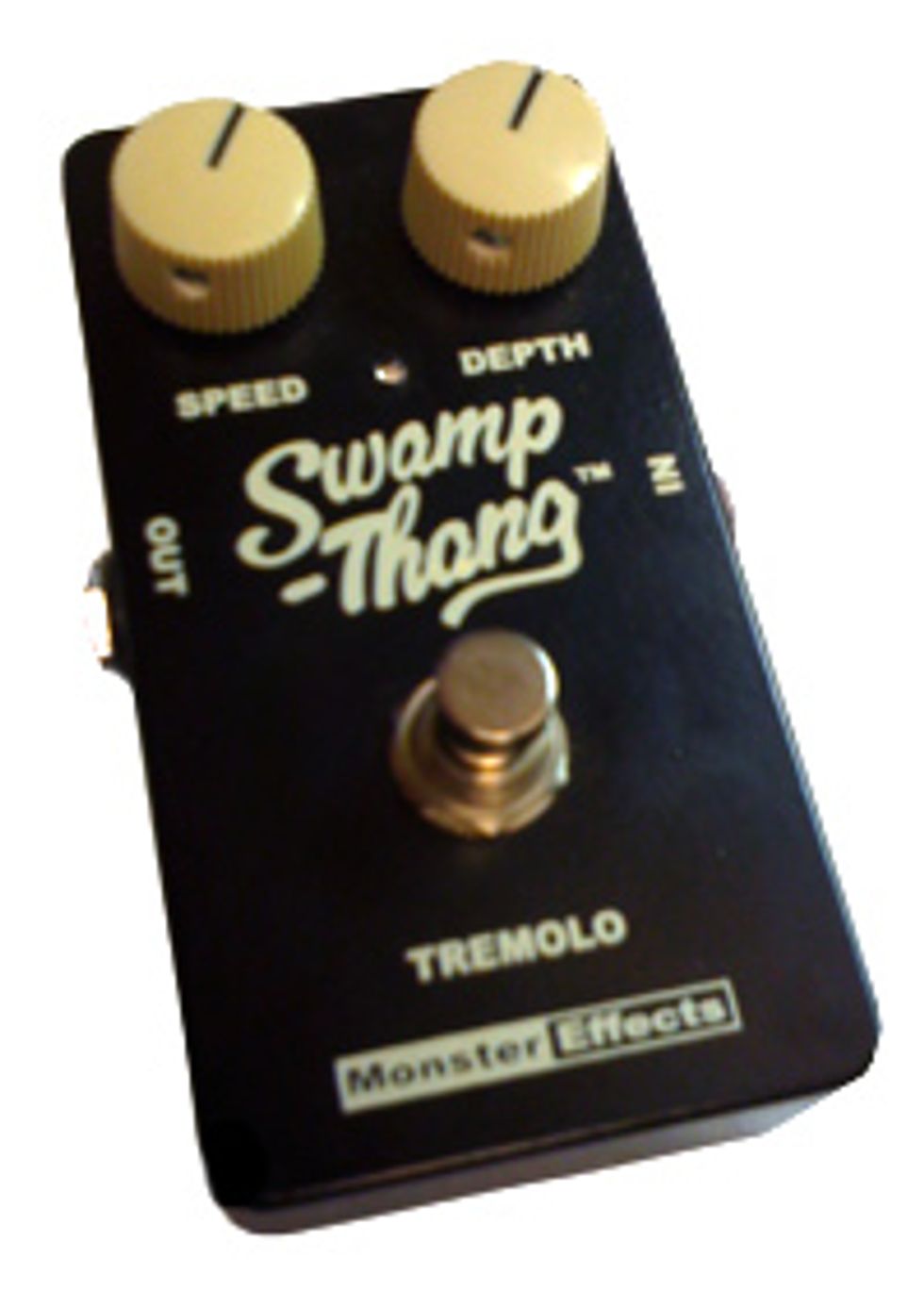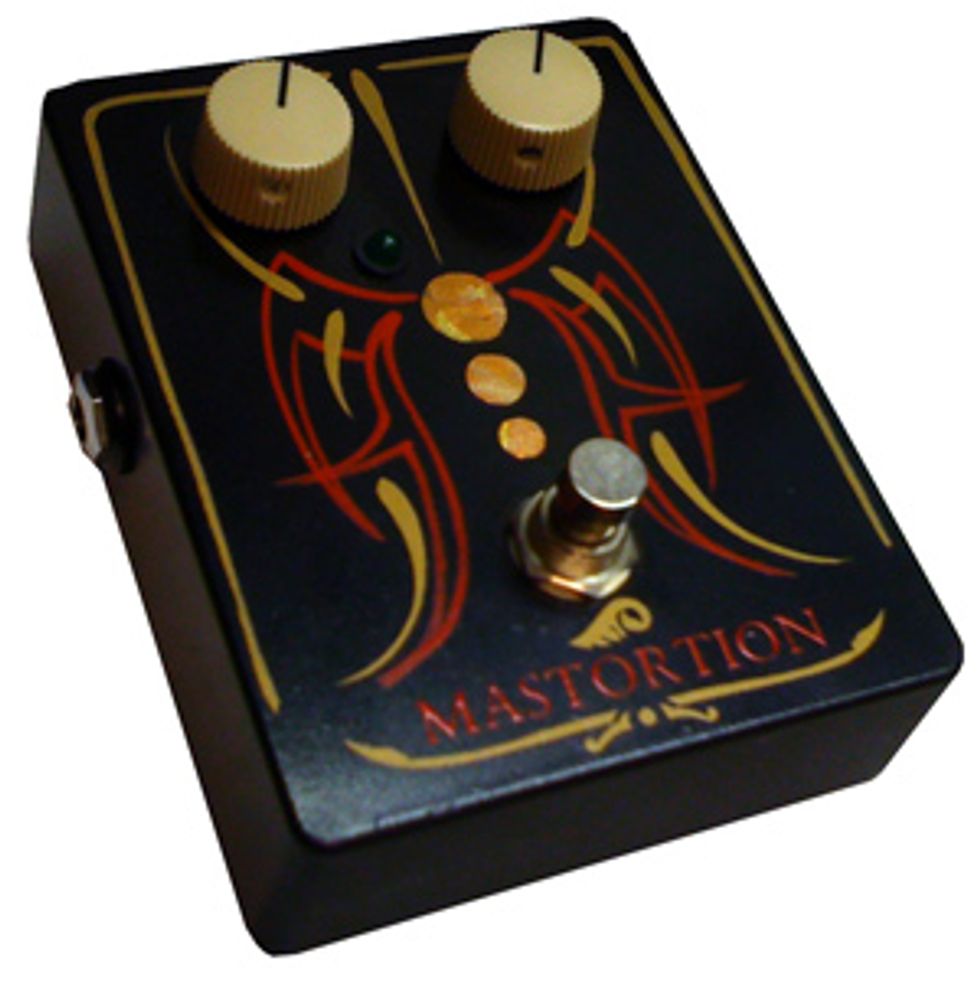Formed in 2001, Monster Effects is the labor of love of electronics ace John Spears. Almost immediately after the company’s inception, his designs started to garner the attention of players everywhere. Spears’ original Swamp-Thang pedal has become a favorite amongst “in the know” guitarists, prized for its remarkable tonal similarities to the original Fender circuits.
Since 2001, Monster Effects has branched out with such releases as the Vibezilla (vibrato/tremolo), El Dorado (overdrive) and Atom Amplifiers, which are Spears’ point-to-point, hand-built amps. Monster Effects have even captured the ears of Brent Hinds, lead guitarist for Mastodon, which lead to the Mastortion pedal, a collaboration between Hinds and Spears. The Mastortion is a new, two-knob overdrive bearing artwork and tone reminiscent of the popular metal band. The pedal made its debut on Mastodon’s blistering cover of the Metallica classic, “Orion,” aptly demonstrating its ability as a powerful rhythm and lead tool.
Spears has also put time into revamping the revered Swamp-Thang, shrinking the size of the enclosure and implementing true-bypass and an over-voltage protection circuit. As a fan of John’s original Swamp-Thang (and a huge fan of Mastodon), I was super excited to be able to give these pedals a run through, and they certainly didn’t disappoint.
Swamp-Thang Tremolo Pedal
 | |
| Download Example 1 | |
| Recorded with a Grosh ElectraJet Standard into a Vox Night Train head into a Bogner 2x12 w/ Vintage 30s | |
I plugged a 2007 Fender American Standard Stratocaster, with the Swamp-Thang in line, into the first input of the second channel of the Bandmaster, making sure that the onboard tremolo was disengaged. After activating the Swamp-Thang with the Speed knob fully counter-clockwise and playing some straightforward I-IV-V blues riffing, I noticed that the Swamp-Thang had a rather extreme effect on the sound. Even at the lowest setting of Speed and the Depth control at the 9 o’clock position, the effect was rather quick and hardly subtle. Tonally, it sounded fantastic.
The Depth control really comes into play in fashioning a good tone, offering an exceptionally smooth taper (the control was perfectly calibrated to control the effect smoothly without any sudden jump in depth). At lower settings of the Depth control, I could really hear the ramping up of the volume, and a smooth decay at the end. This is especially nice, as a lot of tremolo effects seem to have a rather “sputtering” nature to them, giving a really harsh, staccato-type effect to the sound. Even with both controls at their most extreme settings, the edges of each pulse were smooth and pleasing to the ear, with no choppy high-end frequencies.
Wondering how this fine example of tremolo circuitry would hold up against a legendary one, I activated the tremolo effect on the Bandmaster, and set the Speed and Intensity controls at noon. When A/B’ing them, it was rather difficult to tell a difference. Jamming the riff to Radiohead’s “Planet Telex” (a great example of tremolo use), I noticed that the Swamp-Thang was stronger and more muscular sounding, taking the tone and moving the volume up and down in a very immediate way. The Bandmaster’s circuit was much more fluid, with a stronger presence of high end and lack of low end punch in each pulse.
The vintage-vibe was strong with both subjects, but in the end I felt that the Swamp-Thang edged the Fender out. It had everything that the Bandmaster tremolo effect had, but with the ability to keep the tone punchy without cutting any other frequencies out when engaged. The only leg that the Fender had was the ability to craft a slower, more pulsating effect. If the Swamp-Thang’s Speed control could be altered to produce even lower speeds, it would be near perfect.
Buy if...
You’re in love with classic tremolo effects and want an affordable, useful alternative to expensive, vintage models.
Skip if...
A subtler effect is needed.
Rating...
MSRP $199.95 - Monster Effects - monstereffects.com |
Mastortion Overdrive Pedal
 | |
| Download Example 1 | |
| Recorded with a 2007 Gibson Flying V with stock pickups into 1973 Marshall Super Bass into a Bogner 2x12 w/ Vintage 30s | |
Those players who are frustrated with Fuzz Face-type guitar pedals with no low end to speak of should seriously take note of this device, as the Mastortion exhibited the same type of high end focus and tightness, but with a massive amount of bass available. The pedal has a good amount of sustain, but interestingly has a very, very low noise floor. When I would release a note (lift my finger so I wasn’t fretting anymore, but just touching the string), the sound would die out immediately, as if a gate had been applied to the chain. This tonal quality made the Mastortion perfect for fuzz-infused staccato licks. However, for applications that require unrelenting, saturated metal riffage, I found that it is best to use the Mastortion in conjunction with a light overdrive dialed in from the amp.
Even with the Drive knob maxed, the Mastortion has a surprisingly little amount of gain, about half of what is available from a Big Muff. The range offered from the Volume control was huge, so I was curious about using it for a boost application. I set the Marshall to a moderate gain tone, which was at about 11 o’clock on the volume knob of the bright channel. The results were stunning, to the say the least. For years I’ve experimented with various overdrive pedals, trying to find that one that yields the perfect blend of cut, sustain, clarity and expansiveness. When wielding the Mastortion, my Super Bass head completely opened up into a raging stoner metal monster. The Mastortion infused the high end with a very pleasing fuzz-like edge, and not with the razor-blade type tone that I was used to hearing (and having to dial out) from a lot of other overdrive pedals.
Using the volume knob on my Les Paul offered a great, highly usable range of vintage and modern fuzz sounds, ranging from early Maestro-based Rolling Stones to unrelenting, forceful stoner rock tones, a la Electric Wizard and Orange Goblin. Even with the pedal at higher settings hitting the front end of the amp, the sound was relatively quiet; much quieter than most that I’ve come across. Lead tones were especially fluid and tight, with lots of mids and punch.
The fact that the pedal has a lot of midrange is probably its strongest trait. It is plainly evident that Hinds had his hand in its voicing, as Mastodon’s guitar tone has the same cutting and defined midrange that the Mastortion exhibits. Players often forget that the guitar is a midrange instrument, and the voicing of those frequencies are often key to getting a great tone. Monster Effects did an incredible job with that voicing here.
My only gripe is the lack of a tone knob, which is unfortunately not available to help the player shape their tone further. With the Mastortion, you’re pretty much stuck with the tone that you get; any other alterations have to come from the amplifier, or the guitar itself. While you can get a great range from utilizing those tools, the addition of a tone control (and perhaps a little more onboard gain) would really push the possibilities of this pedal, and without doubt help it reach its true potential.
Buy if...
grinding, edgy and massive guitar tones are the order of the day.
Skip if...
you’re in need of more options, such as a tone control or a gain boost.
Rating...
MSRP $219 - Monster Effects - monstereffects.com |







![Rig Rundown: Russian Circles’ Mike Sullivan [2025]](https://www.premierguitar.com/media-library/youtube.jpg?id=62303631&width=1245&height=700&quality=70&coordinates=0%2C0%2C0%2C0)

















